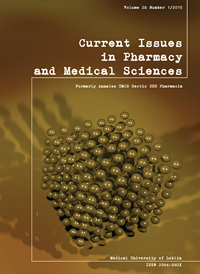Anti-Helicobacter pylori activity in vitro of chamomile flowers, coneflower herbs, peppermint leaves and thyme herbs – a preliminary report
DOI:
https://doi.org/10.1515/cipms-2015-0038Keywords:
chamomile flowers, coneflower herbs, peppermint leaves, thyme herbs, anti-Helicobacter pylori, activityAbstract
Anti-Helicobacter pylori activity in vitro of chamomile flowers, coneflower herbs, peppermint leaves and thyme herbs – a preliminary report Recently, several studies have been undertaken so as to develop more effective therapeutic approaches towards eradicating Helicobacter pylori. Among these is phytotherapy. The aim of this study was to investigate the activity in vitro of the plant extracts obtained from common herbs cultivated in the Lubelszczyzna region. against the reference strain H. pylori ATCC 43504. Among these are thyme herbs, chamomile flowers, peppermint leaves and coneflower herbs. Herein, it was found that the MIC values of the assayed extracts were as follows: the extracts from coneflower herbs showed anti-H. pylori activity with MIC = 31.3-125 μg/ml; the extracts from chamomile flowers demonstrated MIC = 31.3-62.5 μg/ml; the extracts from peppermint leaves had MIC = 15.6-250 μg/ml; and the extracts from thyme herbs revealed MIC = 15.6-62.5 μg/ml, depending on the solvent used. The most active were the extracts obtained with ethyl acetate or ethanol alcohol absolute 99.8%. These showing MIC within the range of 15.6-62.5 μg/ml, while the lowest activity was observed in case of the extract obtained with 70% aqueous ethanol. This last showing MIC within the range of 62.5-250 μg/ml. The MIC values of essential oil components were 15.6 μg/ml for bisabolol and menthol or 31.3 μg/ml for thymol. The obtained data indicate that the assayed herbs possessed promising anti-H. Pylori bioactivity.References
1. Boyanova L.: Comparative evaluation of the activity of plant infusions against Helicobacter pylori strains by three methods. World J. Microbiol. Biotechnol., 30, 1633, 2014. [Web of Science] [CrossRef]
2. Dorman H.J.D, Deans S.G.: Antimicrobial agents from plants: antibacterial activity of plants volatile oils. J. Appl. Microbiol., 88, 308, 2000. [CrossRef]
3. Edris A.E.: Pharmaceutical and therapeutic potentials of essential oils and their individual volatile constituents: A review. Phytother. Res., 21, 308, 2007. [CrossRef]
4. Fadda G., Zanetti S.: In vitro activity of essential oil of Myrtus communis L. against Helicobacter pylori. Int. J. Antimicrob. Agents., 30, 562, 2007. [Web of Science] [CrossRef]
5. Falsafi T. et al.: Chemical composition and anti-Helicobacter pylori effect of Satureja bachtiarica Bunge essential oil. Phytomedicine., 15, 173, 2015. [Web of Science] [CrossRef]
6. French G.L.: Bactericidal agents in the treatment of MRSA infections - the potential role of daptomycin. J. Antimicrob. Chemother. 58, 1107, 2006. [CrossRef]
7. Hazzit M. et al.: Chemical composition and biological activities of Algerian Thymus oils. Food Chem., 116, 714, 2009. [CrossRef]
8. Lang G., Buchbauer G.: A review on recent research results (2008-2010) on essential oils as antimicrobial and antifungals. A review. Flavour Fragr. J., 27, 13, 2012.
9. Njume C. et al.: Volatile compounds in the stem bark of Sclerocarya birrea (Anacardiaceae) possess antimicrobial activity against drugresistant strains of Helicobacter pylori. Int. J. Antimicrob. Agents., 38, 319, 2011. [CrossRef][Web of Science]
10. O`Donnell F. et al.: A study of the antimicrobial activity of selected synthetic and naturally occurring quinolines. Int. J. Antimicrob. Agents., 35, 30, 2010. [CrossRef] [Web of Science]
11. Ohno T. et al.: Antimicrobial activity of essential oils against Helicobacter pylori. Helicobacter, 8, 207, 2003.[CrossRef]
12. Papastergiou V., Georgopoulos S.D., Karatapanis S.: Treatment of Helicobacter pylori infection: past, present and future. World J. Gastrointest. Pathophysiol., 5, 392, 2014. [CrossRef]
13. Rios J.L., Recio M.C.: Medicinal plants and antimicrobial activity. J. Ethnopharmacol. 100, 80, 2005. [CrossRef]
14. Safavi M., Shams-Ardakani M., Foroumadi A.: Medicinal plants in treatment of Helicobacter pylori infections. Pharm. Biol., 28, 1, 2014. [Web of Science]
15. Shikov A.N. et al.: Antibacterial activity of Chamomilla recutita oil extract against Helicobacter pylori. Phytoter. Res., 22, 252, 2008. [CrossRef]
16. Vale F.F., Oleastro M.: Overview of the phytomedicine approaches against Helicobacter pylori. World J. Gastroenterol., 20, 5594, 2014. [Web of Science] [CrossRef]
17. Vitor J.M.B., Vale F.F.: Alternative therapies for Helicobacter pylori: Probiotics and phytomedicine. FEMS Immunol. Med. Microbiol., 63, 153, 2011. [Web of Science]
18. Wiegand I., Hilpert K., Hancock R.E.W.: Agar and broth dilution methods to determine the minimal inhibitory concentration (MIC) of antimicrobial substances. Nat. Protoc. 3, 163, 2008. [CrossRef] [Web of Science]
Downloads
Published
Issue
Section
License
Copyright (c) 2015 Authors

This work is licensed under a Creative Commons Attribution-NonCommercial-NoDerivatives 3.0 Unported License.


